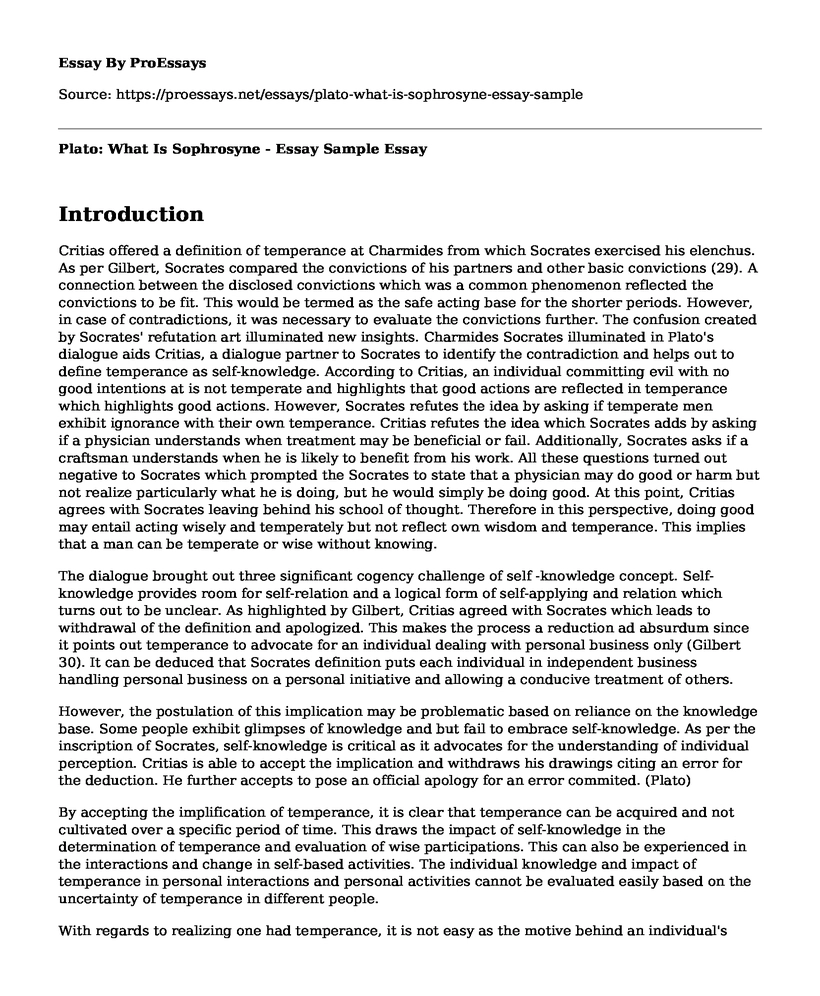Introduction
Critias offered a definition of temperance at Charmides from which Socrates exercised his elenchus. As per Gilbert, Socrates compared the convictions of his partners and other basic convictions (29). A connection between the disclosed convictions which was a common phenomenon reflected the convictions to be fit. This would be termed as the safe acting base for the shorter periods. However, in case of contradictions, it was necessary to evaluate the convictions further. The confusion created by Socrates' refutation art illuminated new insights. Charmides Socrates illuminated in Plato's dialogue aids Critias, a dialogue partner to Socrates to identify the contradiction and helps out to define temperance as self-knowledge. According to Critias, an individual committing evil with no good intentions at is not temperate and highlights that good actions are reflected in temperance which highlights good actions. However, Socrates refutes the idea by asking if temperate men exhibit ignorance with their own temperance. Critias refutes the idea which Socrates adds by asking if a physician understands when treatment may be beneficial or fail. Additionally, Socrates asks if a craftsman understands when he is likely to benefit from his work. All these questions turned out negative to Socrates which prompted the Socrates to state that a physician may do good or harm but not realize particularly what he is doing, but he would simply be doing good. At this point, Critias agrees with Socrates leaving behind his school of thought. Therefore in this perspective, doing good may entail acting wisely and temperately but not reflect own wisdom and temperance. This implies that a man can be temperate or wise without knowing.
The dialogue brought out three significant cogency challenge of self -knowledge concept. Self-knowledge provides room for self-relation and a logical form of self-applying and relation which turns out to be unclear. As highlighted by Gilbert, Critias agreed with Socrates which leads to withdrawal of the definition and apologized. This makes the process a reduction ad absurdum since it points out temperance to advocate for an individual dealing with personal business only (Gilbert 30). It can be deduced that Socrates definition puts each individual in independent business handling personal business on a personal initiative and allowing a conducive treatment of others.
However, the postulation of this implication may be problematic based on reliance on the knowledge base. Some people exhibit glimpses of knowledge and but fail to embrace self-knowledge. As per the inscription of Socrates, self-knowledge is critical as it advocates for the understanding of individual perception. Critias is able to accept the implication and withdraws his drawings citing an error for the deduction. He further accepts to pose an official apology for an error commited. (Plato)
By accepting the implification of temperance, it is clear that temperance can be acquired and not cultivated over a specific period of time. This draws the impact of self-knowledge in the determination of temperance and evaluation of wise participations. This can also be experienced in the interactions and change in self-based activities. The individual knowledge and impact of temperance in personal interactions and personal activities cannot be evaluated easily based on the uncertainty of temperance in different people.
With regards to realizing one had temperance, it is not easy as the motive behind an individual's actions cannot be outlined. This may be unfolded to the particular person evaluated for tolerance. In this case, it is difficult to justify if an individual had temperance.
Conclusion
In conclusion, based on the evaluation of partners contradictions, Socrates was able to give Critias a new understanding and meaning of Plato's sophrosyne. This highlighted the effectiveness of the Socrates contradiction with partners ideas.
Works Cited
Gilbert, Pal Rykkja. Platonic sophrosyne: many-headed beast or a simple creature?. MS thesis. 2010.
Plato, By. Plato: Complete Works. Access and Diversity, Crane Library, University of British Columbia, 2015.
Cite this page
Plato: What Is Sophrosyne - Essay Sample. (2022, Nov 21). Retrieved from https://proessays.net/essays/plato-what-is-sophrosyne-essay-sample
If you are the original author of this essay and no longer wish to have it published on the ProEssays website, please click below to request its removal:
- Why It Is Important to Have a Manifesto
- Nietzsche's Philosophy
- Code of Ethics in Management Essay
- Paper Example on Modern Rangers: Ethics and Leadership
- Social Identity and Self-Categorization - Research Paper
- Ethics: The Cornerstone of Professionalism & Life's Standards - Essay Sample
- Compare and Contrast Utilitarianism and Deontological theories







